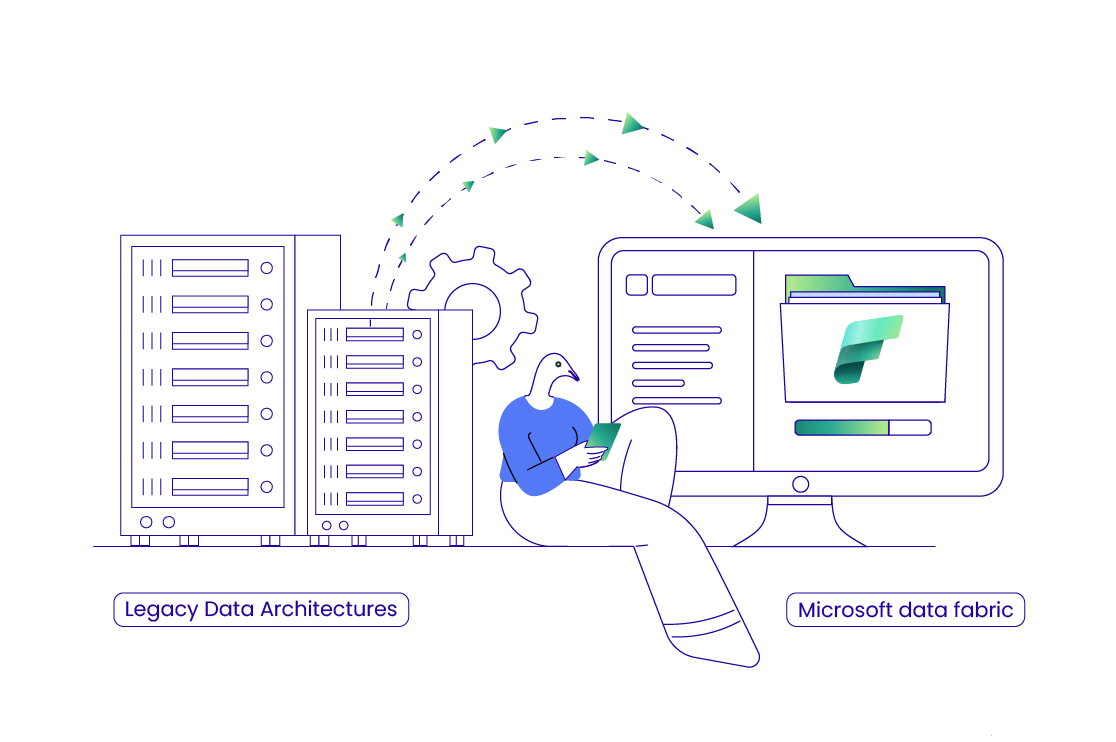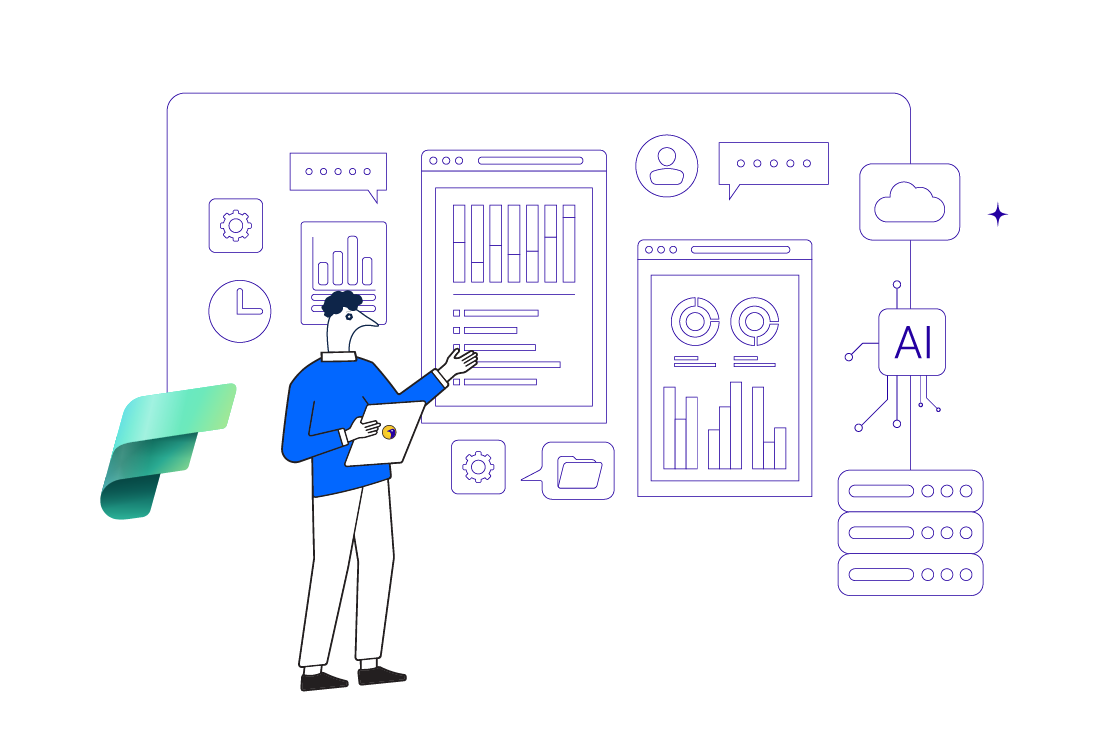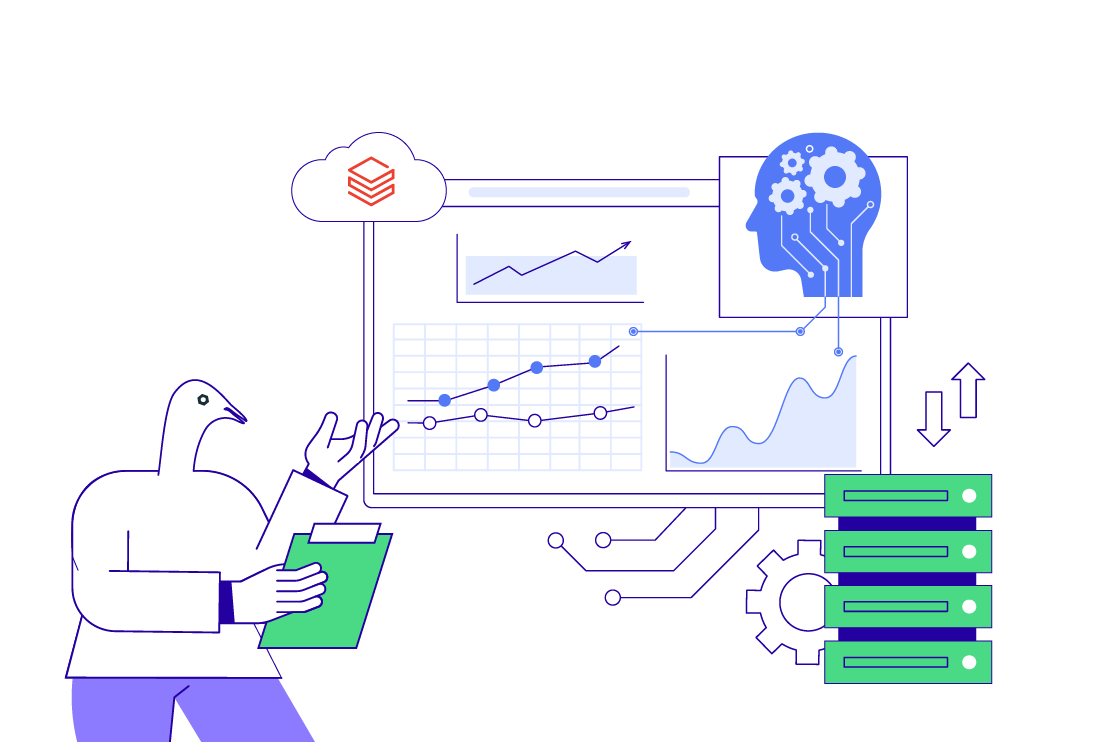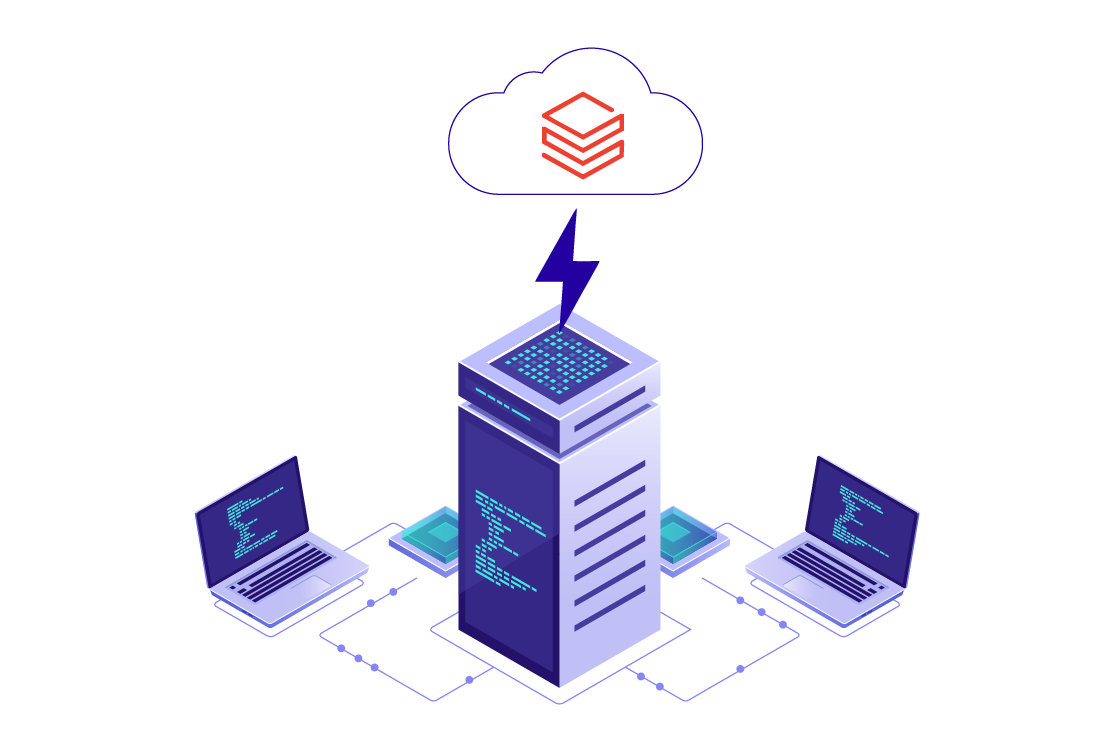Legacy data, stored in outdated systems and formats, becomes a growth bottleneck by hindering a company’s agility, efficiency, and ability to make informed decisions.
While legacy data itself can be valuable for historical analysis, the infrastructure that holds it creates obstacles that slow down or outright to prevent modernization.
Legacy Data Architecture was not designed to integrate with modern cloud-based tools, APIs, or data analytics platforms. This creates isolated “data silos” where different departments or systems cannot share information effectively.
When businesses attempt to combine this data, they encounter quality and consistency issues that make it unreliable for analysis.
- Explain how legacy data acts as a growth bottleneck
- Risks of remaining with legacy systems versus benefits of migrating to Microsoft data fabric
- Key migration risks that CXOs should monitor
- ROI benefits of migration, focusing on speed, cost, and resilience.
- Suggest action steps for CXOs to take.
- Conclusion
- FAQs
With data trapped in silos, it’s impossible to get a unified, real-time view of business operations. Outdated data architecture makes it difficult to implement and benefit from these technologies, stalling a company’s innovation and growth.
Built on outdated technology, Legacy Data Architecture is often slow, cumbersome, and prone to crashes. This inefficiency can impact employee productivity and customer satisfaction. Older systems often lack security protocols to protect against modern cyber threats. They also make it difficult for companies to comply with & migrate Legacy Data with evolving data privacy regulations like GDPR, leading to potential breaches, fines, and reputational damage.
Risks Of Remaining with Legacy Systems Versus Benefits of Migrating to Microsoft data fabric
Remaining with legacy systems risks high maintenance costs, security vulnerabilities, and a lack of flexibility, while migrating to a modern platform like Microsoft fabric migration offers benefits like increased scalability, reduced costs, and improved security, but requires a strategic migration to mitigate its own set of risks.
Key Risks associated with Legacy Systems
High maintenance costs: Old systems require costly upkeep, dedicated specialists in outdated technology, and frequent hardware replacements.
Security vulnerabilities: Aging systems often have unpatched security flaws, making them easy targets for cyberattacks.
Inflexibility: Legacy systems struggle to adapt to new business requirements, market changes, or regulatory updates.
Data silos: Disconnected legacy systems can create data silos, hinder integration, and limit a holistic view of the business.
Skill shortages: Finding and retaining staff with expertise in outdated technologies can be difficult and expensive.
Performance issues: Inefficient software can lead to performance bottlenecks and reduce employee productivity.
Top Benefits of Migrating Legacy System to Microsoft Data Fabric
Modern infrastructure: A platform like Microsoft data fabric provides a modern, cloud-based, and scalable environment.
Reduced costs: By migrating, you can eliminate the high maintenance costs associated with legacy hardware and software.
Improved security: A modern platform offers better security features and is easier to keep up to date.
Increased agility: A new system allows the business to adapt more quickly to market changes and new opportunities.
Better performance: A modern platform can offer significant performance improvements over legacy systems.
Centralized data: A platform like Microsoft data fabric can help break down data silos, enabling better analytics and decision-making.
Key Migration Risks That CXOs Should Monitor
For CXOs overseeing any major Microsoft fabric migration, such as moving to the cloud or a new enterprise system, the risks can be categorized into strategic, financial, operational, security, and human factors. These risks can impact business continuity, customer trust, and the bottom line if not properly monitored and managed.
Strategic and planning risks
Migrating without any defined business cases or being unable to align them with long-term business goals usually leads to wasted investment. Improper planning results in unwanted complexities, delays, and exceeding the budget. Also, getting over-dependent on a single cloud service restricts flexibility and options for innovation.
Operational risks
Imagine constant interruptions during the Microsoft fabric migration process. Now, imagine the same again, but this time for large and complex datasets. This causes major disruption to businesses, resulting in loss of revenue and customer satisfaction. Plus, any legacy application that’s not compatible with the modern cloud infrastructure would end up setting costly re-engineering and replatforming expenses.
Data risks
Data can get corrupted, degraded, or even lost in terms of quality. This happens majorly due to format mismatches, technical glitches, or simple technical errors. This causes flaws in reporting, leading to incorrect decision making.
Human and organizational risks
Without a clear communication strategy to implement and proper training to implement them, the entire Microsoft fabric migration process can go in vain. Gap in-house skills related to cloud architecture, security, and management would lead to expensive mistakes and less configuration. Due to this, employees and team members resist new systems and processes.
Security and compliance risks
Sensitive data become vulnerable during transit and in new work environments. This exposes the data to attack, increasing the chances of breach. In situations where regulatory requirements cannot get mapped to the new environment, it causes reputational damage.
ROI Benefits of Microsoft Fabric Migration, Focusing on Speed, Cost, and Resilience
Migrating to the cloud can yield significant returns on investment (ROI) by improving business outcomes related to speed, cost, and resilience. While the process requires a thorough cost-benefit analysis that includes intangible benefits, the long-term strategic advantages often far outweigh the initial investment.
ROI from speed: Cloud migration dramatically accelerates business operations and development, turning IT into a strategic asset rather than a bottleneck. Automation of routine tasks like patching and backups also contributes to a more productive workforce.
ROI from cost optimization: Microsoft data fabric integration transforms IT spending from a capital expenditure (CapEx) model, with expensive hardware and data center overhead, to a more flexible operational expenditure (OpEx) model. Significant cost savings come from lower energy consumption, less need for on-premises maintenance staff, and automated operational tasks handled by the cloud provider.
ROI from resilience: Cloud migration provides a foundation for operational stability and risk mitigation, defending against costly outages and security threats. By spreading data across multiple regions or clouds (multi-cloud), companies can ensure seamless operations even if one region experiences an outage. This protects revenue and preserves customer trust.
Action Steps for CXOs To Take
As a C-level executive, guiding Microsoft fabric migration requires a strategic approach that aligns technology with business objectives, manages costs, and mitigates risks.
Microsoft data fabric unifies data integration, warehousing, and business intelligence into a single, AI-powered platform, simplifying operations and accelerating time-to-insight.
Here are the key action steps for CXOs to lead to a successful migration from Legacy Data Architecture to Microsoft Data Fabric migration.
Establish a strategic vision and a business-first approach instead of focusing solely on the technical aspects, frame the migration around the business value it will deliver.
Conduct a comprehensive audit and assessment. This will help in gaining a full understanding of your current data landscape and the path to modernization.
Choose the right migration strategy. Finalize an approach that balances speed, risk, and long-term optimization.
Execute with a focus on data integrity and risk mitigation. Oversee the migration to ensure a smooth transition with minimal business disruption.
Manage costs and resources proactively. Maintain financial oversight throughout the project.
Drive change management and user adoption. Remember that technology is only half the battle; people are the other half.
Enable continuous monitoring and optimization: The migration is a starting point, not the finish line.
Conclusion
Microsoft fabric migration is one of the critical strategic cloud data services imperatives for CXOs to overcome the limitations of legacy data architectures. The platform’s unified, AI-powered approach helps eliminate costly data silos and reduces manual effort, delivering significant ROI through enhanced speed, cost optimization, and resilience.
For a successful Microsoft data fabric integration, CXOs must champion a clear business-first strategy, focus on phased execution, and prioritize talent development only from leading organizations such as BluEnt. The journey is not just a technology upgrade but a strategic move to build an agile, data-driven organization.
FAQs
What are the primary risks of staying with a legacy data system?Continuing to rely on legacy systems poses several significant risks that can hinder growth and create operational vulnerabilities. Maintenance of outdated hardware and software, along with staffing challenges for legacy technologies, is expensive and inefficient. Older systems are not built to withstand modern cyber threats or meet evolving data privacy regulations, increasing the risk of breaches, fines, and reputational damage.
How does Microsoft data fabric deliver significant ROI and cost savings?Microsoft data fabric delivers ROI through several key mechanisms including reduced infrastructure costs, flexible pricing, faster time-to-insight, and higher efficiency.
What migration strategy is best for my organization?The right strategy depends on your organization’s specific needs, budget, and risk tolerance. These are the Lift-and-shift, Rebuild and optimize, and Phased approach.
How can I ensure data security and governance during and after migration?Effective data governance is built into Microsoft data fabric using Microsoft Purview to enforce data policies, manage access controls, and classify sensitive data across your entire data estate. It also helps in ensuring all data transfers are encrypted during migration to prevent interception.
What is the impact of AI on the Microsoft data fabric migration?Microsoft data fabric is an AI-powered platform designed to help organizations move from descriptive to predictive insights. Microsoft data fabric allows you to build, deploy, and operationalize machine learning models directly on your data. By enriching your data with AI predictions, business analysts can incorporate predictive insights into their reports, enabling proactive decisions.












 How Microsoft Data Fabric Integration Ensures Compliance, Security & Standardization for Enterprises
How Microsoft Data Fabric Integration Ensures Compliance, Security & Standardization for Enterprises  Real-Time Intelligence in Microsoft Fabric: Enabling CXOs With Faster Decisions
Real-Time Intelligence in Microsoft Fabric: Enabling CXOs With Faster Decisions  Scaling AI & Analytics on Databricks: CXO Use Cases that Deliver
Scaling AI & Analytics on Databricks: CXO Use Cases that Deliver  From Cost to Value: ROI Comparison Between Databricks and Traditional Data Warehousing
From Cost to Value: ROI Comparison Between Databricks and Traditional Data Warehousing 
